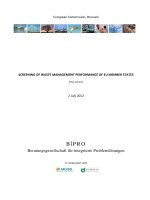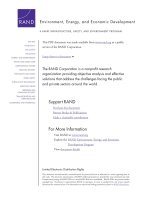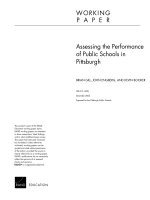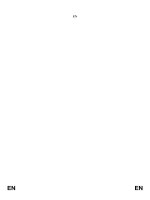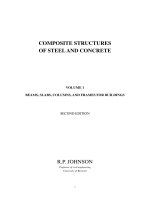Impact performance of steel concrete steel sandwich structures
Bạn đang xem bản rút gọn của tài liệu. Xem và tải ngay bản đầy đủ của tài liệu tại đây (6.76 MB, 276 trang )
IMPACT PERFORMANCE OF
STEEL-CONCRETE-STEEL SANDWICH
STRUCTURES
KAZI MD. ABU SOHEL
NATIONAL UNIVERSITY OF SINGAPORE
2008
IMPACT PERFORMANCE OF
STEEL-CONCRETE-STEEL SANDWICH
STRUCTURES
KAZI MD. ABU SOHEL
(B.Sc. Eng, BUET, M.Sc. Eng., BUET, M. Eng., NUS)
A THESIS SUBMITTED
FOR THE DEGREE OF DOCTOR OF PHILOSOPHY
DEPARTMENT OF CIVIL ENGINEERING
NATIONAL UNIVERSITY OF S
INGAPORE
2008
Acknowledgements
Acknowledgements
The author wishes to express his sincere gratitude to his supervisors, Prof. Liew Jat
Yuen, Richard and Prof. Koh Chan Ghee for their personal commitment, patience,
interesting discussion, invaluable guidance and constructive advices throughout the
course of this study. The author would also like to thank Assoc. Prof. Tan Kiang Hwee
and Assoc. Prof. Wee Tiong Huan for their helpful suggestions and comments.
The author’s heartfelt appreciation is dedicated to Dr. Chia Kok Seng, Dr. Lee Siew
Chin, Dr. Dai Xuexin and Mr. Wang Tongyun for their contributions and continuous
supports.
Sincere thanks are also extended to the Maritime and Port Authority of Singapore, and
Keppel Offshore & Marine Ltd for providing the research grant through the Centre for
Offshore Research & Engineering, NUS.
The kind assistance from all the staff members of the NUS Concrete and Structural
Engineering Laboratory is deeply appreciated. Special thanks goes to Ms. Tan Annie,
Mr. Ang Beng Oon, Mr. Koh Yian Kheng, Mr. Choo Peng Kin and Mr. Ishak Bin A
Rahman for their continuous support during experimental pace of the project.
Finally, special thanks and loves go to his wife (Saima Sultana), son, parents and
friends for their moral supports, mutual understanding and constant loves. Thank you
for making this study possible and May God bless all of you…
i
Table of contents
TABLE OF CONTENTS
Acknowledgements ……………………………………………………………………i
Table of contents……………………………………………………………………….ii
Summary……………………………………………………………………………….ix
List of Tables………………………………………………………………………….xii
List of Figures……………………………………………………………………… xiv
List of Symbols……………………………………………………………………… xx
Chapter 1 Introduction
1.1 Overview……………………………………………………………………… 1
1.2 Background…………………………………………………………………… 2
1.3 Objectives and scope………………………………………………………… 6
1.4 Outline of the thesis…………………………………………………………….8
Chapter 2 Literature review
2.1 General……………………………………………………………………… 12
2.2 Steel-concrete-steel (SCS) sandwiches……………………………………… 12
2.2.1 SCS sandwich without shear connectors………………………………13
2.2.2 SCS sandwich with angle shear connectors……………………………14
ii
Table of contents
2.2.3 SCS sandwich with headed shear connectors………………………….14
2.2.4 Bi-Steel composite panel………………………………………………20
2.3 Lightweight concrete core for SCS sandwiches……………………………….22
2.4 Shear connectors used for SCS sandwich constructions………………………23
2.5 Impact behaviour of beams and plates……………………………………… 25
2.5.1 Contact law…………………………………………………………….26
2.5.2 Analysis of low velocity impact on beams and plates…………………29
2.5.3 Low velocity impact test on beams and plates…………………………30
2.6 Observations arising from literature review………………………………… 33
Chapter 3 Static behaviour of SCS sandwich beams
3.1 Introduction……………………………………………………………………36
3.2 Development of lightweight sandwich beams…………………………………37
3.2.1 Concept of using J-hook connector in SCS sandwich beams………….37
3.2.2 Lightweight concrete core…………………………………………… 38
3.3 Analysis of SCS sandwich beam subject to static load……………………….39
3.3.1 Flexural resistance of SCS sandwich beam section……………………39
3.3.1.1 Elastic approach………………………………………………39
3.3.1.2 Plastic approach……………………………………………….41
3.3.2 Shear resistance of SCS sandwich beam section………………………44
3.3.3 Deflection………………………………………………………………45
3.4 Test programme……………………………………………………………….47
3.4.1 Push out tests on SCS sections…………………………………………47
3.4.2 SCS beam specimens and test set-up………………………………… 48
3.5 Test results and discussions……………………………………………………49
iii
Table of contents
3.5.1 Push-out tests………………………………………………………… 49
3.5.1.1 Failure loads and failure modes……………………………….49
3.5.1.2 Comparison of test results with theoretical predictions……….51
3.5.2 Beam tests…………………………………………………………… 52
3.5.2.1 Load deflection behaviour…………………………………….52
3.5.2.2 Cracking behaviour of concrete core………………………….53
3.5.2.3 Maximum load and failure mode…………………………… 54
3.5.2.4 Effect of fibres…………………………………………………56
3.5.2.5 Effect of concrete strength…………………………………….57
3.6 Discussion on analytical predictions………………………………………… 58
3.7 Summary………………………………………………………………………59
Chapter 4 Force-indentation relations for SCS
sandwich panels
4.1 Introduction………………………………………………………………… 73
4.2 Impact between projectile and SCS sandwich panel……………………… …74
4.3 Force-indentation relations…………………………………………………….74
4.3.1 Elastic indentation…………………………………………………… 74
4.3.2 Plastic indentation…………………………………………………… 76
4.3.3 Unloading …………………………………………………………… 79
4.4 Impact force and indentation-time history…………………………………….80
4.5 Numerical procedure………………………………………………………… 81
4.6 Strain rate effects on material strength……………………………………… 83
4.7 Experimental investigation…………………………………………………….84
4.7.1 Test specimens…………………………………………………………84
iv
Table of contents
4.7.2 Test set-up…………………………………………………………… 84
4.8 Impact test results and discussion…………………………………………… 86
4.8.1 Impact damage…………………………………………………………86
4.8.2 Denting in the sandwich panel…………………………………………87
4.8.3 Impact force-time history………………………………………………88
4.9 Comparison of analytical results with experimental results………………… 89
4.10 Summary………………………………………………………………………91
Chapter 5 Response of SCS sandwich beams to
impact loading
5.1 Introduction………………………………………………………………… 102
5.2 Structural behaviour of sandwich beams under impact………………………103
5.3 Impact test on SCS sandwich beams…………………………………………104
5.3.1 Sandwich beam specimens……………………………………………104
5.3.2 Experimental procedure………………………………………………104
5.3.3 Test set-up………………………………………………………… 105
5.4 Test results and discussion………………………………………………… 107
5.4.1 Damage analysis of sandwich beams under impact load…………… 107
5.4.2 Displacement and strain history ………………………………………108
5.4.3 Impact force-time history…………………………………………… 110
5.5 Residual flexural strength of beams after impact…………………………….113
5.6 Analysis of impact between projectile and sandwich beam………………….114
5.6.1 force-indentation relation…………………………………………… 114
5.6.1.1 Elastic indentation ………………………………………….114
5.6.1.2 Plastic indentation ………………………………………….115
v
Table of contents
5.6.1.3 Unloading …….…………………………………………… 115
5.6.2 Global response of beam under impact load………………………….116
5.6.2.1 Elastic response………………………………………………116
5.6.2.2 Numerical procedure…………………………………………117
5.6.2.3 Elastic-plastic analysis using SDOF…………………………118
5.6.3 Strain rate effects on material strength……………………………… 120
5.7 Comparison of analytical results with test results……………………………121
5.7.1 Impact force-time history…………………………………………… 121
5.7.2 Displacement-time history……………………………………………123
5.8 Summary…………………………………………………………………… 124
Chapter 6 Response of SCS sandwich slabs to
impact loading
6.1 Introduction………………………………………………………………… 140
6.2 Impact test on SCS sandwich slabs………………………………………… 141
6.2.1 Test program………………………………………………………….141
6.2.2 Preparation of test specimens…………………………………………141
6.3 Test set-up……………………………………………………………………142
6.4 Results and discussion……………………………………………………… 145
6.4.1 Damage analysis of SCS sandwich slabs…………………………… 145
6.4.2 Local indentation due to impact………………………………………147
6.4.3 Displacement-time history……………………………………………149
6.4.4 Impact force-time history…………………………………………… 151
6.5 Analysis of impact between projectile and SCS sandwich slab 152
6.5.1 Force-indentation relations for SCS sandwich slab………………… 152
vi
Table of contents
6.5.1.1 Elastic indentation………………………………… ….……152
6.5.1.2 Plastic indentation……………………………………………153
6.5.1.3 Unloading …….………………………………………… 154
6.5.2 Global slab response under impact load………………………………154
6.5.2.1 Elastic analysis……………………………………………….154
6.5.2.2 Plastic analysis……………………………………………….157
6.5.3 Energy balance model……………………………………………… 157
6.5.4 Punching resistance………………………………………………… 161
6.6 Comparison of analytical results with test results……………………………162
6.7 Summary…………………………………………………………………… 164
Chapter 7 Finite element analysis
7.1 Introduction………………………………………………………………… 182
7.2 Simplified FE model of J-hook shear connectors…………………………….183
7.3 Material models………………………………………………………………185
7.3.1 Concrete core model………………………………………………….185
7.3.2 Projectile and steel bars support model……………………………….188
7.3.3 Steel face plates and shank of J-hook connector model………………188
7.4 Strain rate effect…………………………………………………………… 189
7.5 Contact model- Lagrangian formulation…………………………………… 190
7.6 FE Simulation of 300 mm x 300 mm SCS sandwich for local impact………191
7.6.1 FE model…………………………………………………………… 191
7.6.2 Boundary conditions………………………………………………….192
7.7 FE model of SCS sandwich beams subjected to impact…………………… 192
7.7.1 FE model…………………………………………………………… 192
vii
Table of contents
viii
7.7.2 Boundary conditions………………………………………………….194
7.8 FE model of 1.2 m×1.2 m SCS sandwich slabs subject to impact… 194
7.8.1 FE model…………………………………………………………… 195
7.8.2 Boundary conditions………………………………………………….196
7.9 Results and discussion……………………………………………………… 196
7.9.1 Force-indentation for local impact specimens……………………… 196
7.9.2 Impact on SCS sandwich beams…………………………………… 197
7.9.3 Impact on SCS sandwich slabs……………………………………….199
7.9.3.1 Permanent deformation of bottom steel face plate………… 199
7.9.3.2 Central displacement time-history of sandwich slabs……… 200
7.9.3.3 Response of J-hook connectors………………………………201
7.10 Summary…………………………………………………………………… 202
Chapter 8 Conclusions and recommendations
8.1 Review on completed research work…………………………………………221
8.2 Conclusions………………………………………………………………… 224
8.3 Recommendations for further studies……………………………………… 229
References ……………………………………………………………………… 231
Appendix A 241
Appendix B……………………………………………………………………… 249
Publications……………………………………………………………………….250
Summary
Summary
The aim of this research is to assess the impact performance of Steel-Concrete-Steel
(SCS) sandwich structures comprising a concrete core sandwiched in between two
steel plates which are interconnected by J-hook connectors. Specifically, novel J-hook
connectors that are capable of resisting tension and shear have been developed for this
purpose and their uses are not restricted by the concrete core thickness (compare to Bi-
Steel). The J-hook connectors are firstly welded to the two face plates which are then
interlocked by filling the gap between the face plates with concrete to form composite
sandwich structures. Lightweight concrete of density < 1450 kg/m
3
is used to reduce
the overall weight of the sandwich structures.
Shear transfer capacity of the J-hook connectors between steel plate and concrete is
similar to headed stud connectors confirmed by the push-out tests. Twelve sandwich
beam specimens have been tested to evaluate the flexural and shear performance
subjected to static point load. Parameters investigated include degree of composite
action, concrete with and without fibres and concrete strength. Using Eurocodes as a
basis of design, theoretical model is developed to predict the flexural and shear
capacity considering partial composite and enable construction of sandwich structures
with J-hook connectors. Compared with test results, the predicted capacity is generally
conservative if brittle failure of connectors can be avoided. Test evidence also shows
ix
Summary
that inclusion of 1% volume fraction of fibres in the concrete core significantly
increases the beam flexural capacity as well as its post-peak ductility.
Impact tests were carried out by dropping free weights on to sandwich beams and slabs
to investigate their structural response against impact loads. Test results revealed that
the proposed J-hook connectors provide an effective means to interlock the top and
bottom steel face plates, preventing them from separation during impact. The use of
fibres in concrete core and J-hook connectors enhances the overall structural integrity
of the sandwich beams and slabs when compared with those without such
enhancement. If the impact area is small, low velocity impact by large mass on SCS
sandwich slabs is more likely dominated by local punching.
Contact law for sandwich structures is proposed to predict the contact impact force and
local indentation during impact. To validate this contact law, small sandwich panels
(300 mm ×300 mm) were tested. The developed contact law has been used to predict
the impact forces for the beams and slabs. The elastic-plastic dynamic analysis has
been carried out to predict the global deformation history of the SCS sandwich
structures. Combining both steel plate and shear connector tensile capacity, punching
model has been proposed for designing of SCS sandwich slabs. The experimental
results were used to verify the analytical solution and it was found that the analytical
results agree well (about 93% of accuracy) with experimental results.
In the final part of this research, three-dimensional FE models were developed to
predict the local as well as global responses of SCS sandwich structures due to low
velocity impact. Using discrete beam element to model the interconnection between J-
x
Summary
xi
hooks, the finite element analysis of the specimens predicted the local and global
responses of the slabs and beams with reasonable accuracy. It is found that the steel
plate tends to separate from concrete due to impact but the J-hook connectors prevent
the separation.
The SCS sandwich structures with interconnected J-hook shear connectors can be used
for structural decking purposes and they have better impact performance than SCS
sandwich structures with overlapping stud connectors. The analysis methods and
numerical models developed in this dissertation are the first reported research in
predicting the response of SCS sandwiches with lightweight concrete under low
velocity impact and static loading.
List of tables
List of tables
Table 3.1 Push-out test specimens and specifications for J-hook connectors… 61
Table 3.2 Beam test specimens and specifications for static test ………………61
Table 3.3 Push-out test results and theoretical characteristic shear resistance …62
Table 3.4 Comparison of beam test results with predicted maximum load…… 63
Table 3.5 Check for shear capacity of the beam specimens…………………… 64
Table 3.6 Comparison of theoretical and experimental deflections at two-third of
the maximum beam test load………………………………………….64
Table 4.1 Test specimens and specification for local impact……………………92
Table 4.2 Results of local impact test ………………………………………… 92
Table 4.3 Comparison between experimental results and analytical results of
maximum impact force and permanent deformation (indentation) of
different SCS sandwiches…………………………………………… 93
Table 5.1 Beam specimens and specifications for impact test ……………… 126
Table 5.2 Results of the impact tests.………………………………………… 126
Table 5.3 Strength comparison between beams with and without impact
damage……………………………………………………………….127
Table 5.4 Required input parameters for the prediction of beam impact
response…………………………………………………………… 127
Table 5.5 Comparison of the test and predicted impact forces and
displacements……………………………………………………… 127
Table 6.1 SCS sandwich specimens and specifications for impact test ……….166
xii
List of tables
xiii
Table 6.2 Results of impact test on SCS sandwich slabs …………………… 166
Table 6.3 Damage description of the SCS sandwich slabs…………………….167
Table 6.4 Input parameters for the energy balance model………… …………… 167
Table 6.5 Comparison between experimental measurements and related results
obtained from the energy balance model……………………………168
Table 6.6 Check for steel plate punching capacity of the slab specimens…… 168
Table 7.1 Properties of concrete used in SCS sandwiches…………………… 203
Table 7.2 Parameters for automatic surface-to-surface contact……………… 203
Table 7.3 Sandwich specimens of 300 mm 300 mm for FE simulation (local
impact)……………………………………………………………….203
Table 7.4 Beam specimens and specifications for FE analysis……….……… 204
Table 7.5 SCS sandwich slab (1200 mm 1200 mm) specimens and
specifications for FE analysis……………………………………… 204
Table 7.6 FE results for local impact and comparison with test and analytical
results……………………………………………………………… 205
Table 7.7 FE results for beam impact and comparison with test and analytical
results……………………………………………………………… 205
Table 7.8 FE results for slab impact and comparison with test and analytical
results……………………………………………………………… 205
Table A.1 Properties of the SCS sandwich slab specimens for static test …….248
Table A.2 Results of static test on SCS sandwich slabs ………………… ……248
List of figures
List of figures
Fig 1.1 SCS sandwich construction with overlapping headed stud connectors… 11
Fig. 1.2 Bi-Steel sandwich panel………………………………………………… 11
Fig. 2.1 Stresses at fully plastic stage in sandwich beam………………………… 34
Fig. 2.2 Calculation of the depth of truss, h. (after Xie et al., 2007)………………34
Fig. 2.3 Different types of shear connector……………………………………… 35
Fig. 2.4 The shearing forces distribution mechanism at stud shear connectors
in a composite beam (after Slobodan and Dragoljub, 2002)… …… 35
Fig. 3.1 (a) Arrangement of J-hook connectors in SCS sandwich system
(b) welding of J-hook connector…… ………………………………… 65
Fig. 3.2 (a) SCS sandwich beam under concentrated load
(b) equivalent strut-and-tie model. ……………… 65
Fig. 3.3 (a) SCS beam section (b) equivalent steel section (c) force distribution
in the section and (d) idealized stress distribution ……………………….66
Fig. 3.4 Force distribution in the section at fully plastic stage…………………….66
Fig. 3.5 Cracks developed in SCS sandwich test beam at failure:
(a) cracking in the concrete core at failure (b) strain in the section
and (c) stress distribution……………….……………………………… 66
Fig. 3.6 Schematic diagram of (a) push-out test specimen and
(b) details of the J-hook connector ………………………………… … 67
Fig. 3.7 Push-out test arrangement….…………………………………….……….67
Fig. 3.8 Test arrangement of SCS sandwich beams ………………………………68
Fig. 3.9 Load-slip curves of push out tests (for each J-hook connector)………….69
Fig. 3.10 Typical failure modes for the J-hook connector embedded in the
concrete subjected to direct shear force……………………….……….…69
xiv
List of figures
Fig. 3.11 Comparison of load-deflection curves of test beams ….……………… 70
Fig. 3.12 Typical crack pattern and sequence of appearance……………….………70
Fig. 3.13 Typical beam failure modes due to static load……………………………71
Fig. 3.14 Load versus relative slip between concrete and bottom steel plate
at the beam end ………………………………………………… ……….72
Fig. 4.1 (a) Indentation on the face plate cause by a spherical headed indentor
(b) forces acting on the deformed face plate …………………………… 94
Fig.4.2 (a) Experimental indentation profile in SCS sandwich panel and
(b) Profile equation 94
Fig. 4.3 Local indentation shape by spherical headed indentor:
(a) small indentation and (b) large indentation ………………………… 95
Fig. 4.4 Schematic diagram: (a) specimen and (b) frame to hold the specimen… 95
Fig. 4.5 (a) Specimen for the investigation of local impact behaviour and
(b) picture of the frame holding the specimen during impact…………….95
Fig. 4.6 (a) Experimental set-up for impact on SCS sandwiches and
(b) Projectile into the guide ……………………… …………………….96
Fig. 4.7 Local impact damage (indentation) of SCS sandwich panel due to
projectile impact………………………………………………………… 96
Fig. 4.8 Local impact damage of concrete core due to projectile impact …….…97
Fig. 4.9 Effect of core compressive strength on the permanent dent profile of
face plate of SCS sandwich (6 mm thick face plate)……… …………….98
Fig. 4.10 Effect of fibre on the permanent dent profile of face plate of SCS
sandwich (face plate thickness=4 mm; core =light weight concrete)…….98
Fig. 4.11 Effect of core compressive strength on the impact force history of
SCS sandwich (6 mm thick face plate)……………………………………99
Fig. 4.12 Effect of fibre (PVA) on the impact force history of SCS sandwich
(4 mm thick face plate)……………………………………………………99
Fig. 4.13 Effect of face plate thickness on the impact force history of SCS
sandwich (f
c
=16 MPa)…………………… …………………………… 100
Fig. 4.14 Comparison between analytical indentations (end point of each curve
is the analytical permanent indentation) and experimental permanent
indentations of the SCS sandwiches with different plate thicknesses and
different core strengths……………………………….………………….100
xv
List of figures
Fig. 4.15 Comparison of impact forces between experimental and analytical:
(a)SFCS4-60-4, (b) SFFCS4-60-4(1), (c) SFCS6-60-6,
(d) SLCS4-80-4, (e)SLFCS4-80-4(1) and (f) SCS8-60-8………….…….101
Fig. 5.1 Fig. 5.1 Test set-up for impact on SCS sandwich beams ……………….128
Fig. 5.2 Damage in the SCS sandwich beams after impact…….………… ….…129
Fig. 5.3 Photos captured by high speed camera at different time intervals
at the impact event: (a) SLCS100 and (b) SLFCS100(1)…. ……………130
Fig. 5.4 Mid-span deflections of the SCS sandwich beams under impact load… 131
Fig. 5.5 Strain (longitudinal)-time history of bottom steel plate at mid-span……132
Fig. 5.6 Impact force histories of the SCS sandwich beams…………………… 133
Fig. 5.7 Comparison of static strength between beams without impact damage
and with impact dame (a) SLCS100; and (b) SLFCS100(1)……… ……134
Fig. 5.8 Beam deformation caused by an impact due to a hemispherical
headed projectile……………………………………………………… 135
Fig. 5.9 Idealized force displacement curve of a beam (Resistance function
of a beam)…………… ………………………… …………………… 135
Fig. 5.10 Comparison of predicted results with experiment for beam SLCS100.…136
Fig. 5.11 Comparison of predicted results with experiment for beam
SLFCS100(1)…………………………………………………………… 137
Fig. 5.12 Comparison of predicted results with experiment for beam SLCS200….138
Fig. 5.13 Comparison of predicted results with experiment for beam
SLFCS200(1)……………………………………………………………139
Fig. 6.1 Sandwich slab with J-hook connectors: (a) schematic and
(b) close-up view ……………………………………………………….169
Fig. 6.2 (a) Welding of J-hook connectors by modified welding gun and
(b) concrete casting…………………………………………………… 170
Fig. 6.3 Drop weight impact test machine……………………………………….171
Fig. 6.4 Test set-up for impact on SCS sandwich slabs ……………………… 171
Fig. 6.5 Punching failure through top and bottom plates due to impact
(SCS4-80)…………… ………………………… 172
xvi
List of figures
Fig. 6.6 Impact damage in sandwich slabs: (a) SLCS6-80, concrete cracking
and spalling at the edges of the slab (b) SLFCS6-80, concrete
cracking but no spalling………………………………… …………… 172
Fig. 6.7 Local indentation on the top steel face plates……………………………173
Fig. 6.8 Pictures form high speed camera for different time at the event of
impact; is the maximum deflection……………………………… 174
max
w
Fig. 6.9 Sketch of deformed shape of the impact point of a SCS slab………… 174
Fig. 6.10 Top plate deformation profile after impact……………… ………… …175
Fig. 6.11 Bottom surface permanent deformation profile after impact……………175
Fig. 6.12 Comparison of central deflection-time histories of the sandwich slabs 176
Fig. 6.13 Bottom plate profile at maximum deflection during impact
captured by potentiometer……………………………………………….176
Fig. 6.14 Comparison of impact force-time histories for various sandwich slabs…177
Fig. 6.15 (a) Deformation of sandwich slab caused by a hemispherical-headed
projectile impact and (b) schematic diagram of the slab deformation… 178
Fig. 6.16 Local indentation profile in SCS sandwich slab due to
Hemispherical-headed projectile impact……………………………… 178
Fig. 6.17 Local indentation shape by spherical-headed indentor………………….179
Fig. 6.18 Load-displacement relationship of simply supported SCS sandwich
slabs subjected to static point load at centre. ………… ……………….179
Fig. 6.19 Formation of yield-line mechanism of sandwich slab subjected
to concentrated mid-point load…………………………………….……180
Fig. 6.20 Direct tensile test on J-hook connectors within concrete……………… 180
.
Fig. 6.21 Comparison of impact forces between experimental results and
predicted results ………………….…………………………………… 181
Fig. 6.22 Comparison of projectile displacements between experimental results
and predicted results……………… ……………………………………181
Fig. 7.1 (a) J-hook connectors in the sandwich slab and
(b) FE model of a pair of J-hook connectors………….…………………206
Fig. 7.2 (a) Simplified straight round bar connectors and
(b) Details of discrete beam element……………………………………206
.
xvii
List of figures
Fig. 7.3 Tensile load-displacement relationships of interconnected J-hook
connectors 203………………………………………………………… 207
Fig. 7.4 (a) Illustration of concrete failure surfaces and
(b) material stress-strain curve………………………………………….207
Fig. 7.5 Elastic-plastic behavior with kinematic and isotropic hardening
(after Hallquist, 2007)………………………………………………… 207
Fig. 7.6 Stress-strain relationships: (a) steel plates, (b) J-hook connectors, (c) plain
lightweight concrete and (d) lightweight fibre reinforced concrete…… 208
Fig. 7.7 FE model of 300 mm × 300 mm SCS sandwich panel for local impact 209
Fig. 7.8 (a) Schematic diagram of test set-up and (b) Nodes of top and bottom
steel plate supports that are restricted from vertical translation…………209
Fig. 7.9 Half model of SCS sandwich beam, projectile and support…………… 210
Fig. 7.10 (a) Top support can rotate only through its axis which is highlighted and
(b) fixed boundary condition for the highlighted nodes of steel bars
support………………………………………………………………210
Fig. 7.11 Quarter model of SCS sandwich slab, projectile and support………… 211
Fig. 7.12 Fixed boundary condition for the highlighted nodes of the bars
support………………………………………………………………… 211
Fig. 7.13 Indentation comparison for local impact specimens:
(a) SLCS4-80-4 (b)SCS6-60-6 and (c) SCS8-60-8…………………… 212
Fig. 7.14 Top plate strain contour for local impact specimens (half model)………213
Fig. 7.15 Impact force comparison for local impact specimens………………… 214
Fig. 7.16 Midspan deflection obtained in the FE analysis and compared to
the experiment: (a) SLCS100, (b) SLCS200 and (c) SLCS100S……….215
Fig. 7.17 Comparison of FEM damages pattern with test the beams:
(a) SLCS100 and (b) SLCS100S (beam with stud)…………………… 216
Fig. 7.18 FE simulated permanent deformation of bottom steel plates for sandwich
slabs SCS4-100 and SLCS6-80 in comparison to impact test results… 217
Fig. 7.19 FE simulated permanent deformation of top steel plates for sandwich
slab SLCS6-80 in comparison to impact test result.…………………….217
Fig. 7.20 FE simulated the steel face plates fracture for the sandwich slab
SCS4-80 in comparison to impact test result……………………………218
xviii
List of figures
xix
Fig.7.21 Central deflection obtained in the FE analysis and compared to the
experiment: (a) SCS4-100 (b) SLCS6-80 and (c) SLFCS6-80215…… 219
Fig. 7.22 J-hook connectors in sandwich slab SLCS6-80 at the time of maximum
slab displacement (quarter model)………………………………………220
Fig. A.1 Static test set-up for SCS sandwich slabs……………………………….249
Fig. A.2 Experimental load-deflection curves:
(a) sandwich slabs with light weight concrete core and
(b) sandwich slabs with normal weight concrete core………………….249
Fig. A.3 Yield-line mechanism of sandwich slab subjected to concentrated
mid-point load……………………………………………………………250
Fig. B.1 Modified push-out test set-up for J-hook connectors……………………251
List of symbols
List of symbols
Total central deflection of a sandwich beam
1
Flexural deflection of a sandwich beam
2
Shear deflection of a sandwich beam
t
Time step
m
Deviatoric stress limit for the maximum failure surface
Indentation depth
cr
Critical indentation depth at which steel plate become plastic
m
Maximum indentation depth at maximum contact force
p
Permanent indentation depth
r
Radial strain
Circumferential strain
d
Dynamic strain rate
s
Quasi static strain-rate
Shear modulus reduction factor for cracked concrete
a
Partial material safety factor for steel
c
Partial material safety factor for concrete
v
Partial safety factor for stud
Poison’s ratio
Material density
Stress
c
Compressive stress
0
Plastic tensile strength of steel plate
t
Tensile stress
y
Yield strength of steel
yd
Dynamic yield strength of steel
u
Ultimate tensile strength of steel
xx
List of symbols
FRC
Shear strength of FRC
plain
Shear strength of plain concrete
Rd
Design shear resistance of concrete
Natural circular frequency
A
s
Cross sectional area of steel face plate or stud
A
sw
Total cross sectional area of the J-hook connector within the cross section
a
Radius of deformed zone at impact point
a
v
Shear span of beam
b
Width of a SCS sandwich section or beam
b
s
Length of angle connector
C
Damping coefficient
D
Flexural rigidity of SCS beam section
d
Bar diameter
E
cm
Secant modulus of the concrete
E
c
Modulus of elasticity of concrete
E
s
Modulus of elasticity of steel
F
Force
F
du
Ultimate force carrying capacity of impact damaged beam
F
el
Predicted static force using elastic theory
F
faceplat
e
Plastic membrane force in the steel plate due to local force
F
m
Maximum contact force
F
p
Plastic resistance of SCS sandwich slab
F
pl
ete block
e cylinder
f
c
crete
trength
of concrete
G
russ
Predicted plastic load using plastic approach
F
t
Tensile capacity of the J-hook connectors within concr
f
ck
Characteristic compressive strength concret
Compressive strength of concrete cylinder
'
c
f
Uniaxial compressive strength of con
f
cu
Concrete cube compressive s
f
t
Tensile strength
Shear modulus
/
c
G
Effective shear modulus
h
Depth of the equivalent t
xxi
List of symbols
h
c
Concrete core thickness
h
s
Height of the shear connector
h
t
Total thickness of the sandwich section
L
Span length of SCS sandwich beam or side length of SCS sandwich slab
m
m
ctor for the compression steel plates
d
of sandwich section
ent
am
b
t length
eel plate
.Rd
ovided between maximum and zero moment
N
p
connectors between zero and maximum moment for partial
N
s
connectors between zero and maximum moment for full
ched to the compression plate
L
h
Half length of bea
K
Contact stiffness
K
e
Elastic contact stiffness
K
p
Plastic contact stiffness
k
e
Elastic stiffness of beam
k
r
Unloading stiffness of bea
K
sc
Shear connector stiffness
k
t
Stiffness reduction factor for the tension steel plates
k
c
Stiffness reduction fa
M
Total mass (m
s
+m
b
)
M
pl.R
Plastic moment capacity of sandwich section
M
ult
Ultimate moment capacity
M
Sd
Design bending mom
m
b
Total mass of be
m
e
Effective mass
m
p
Total mass of SCS sandwich sla
m
pl
Plastic moment per uni
m
s
Mass of the projectile
N
Number of time step
N
c.Rd
Compressive force in the compression st
N
cu
Ultimate compressive force in concrete
N
a
Number of shear connectors pr
N
0
Radial force in the steel plate
Number of shear
composite action
Number of shear
composite action
N
t.Rd
Tensile force in the steel plate
n
Modulus ratio between steel and concrete (n=E
s
/E
c
)
P
cRd
Design shear resistance of a shear connector atta
xxii
List of symbols
xxiii
P
Rd
ear resistance of a shear connector attached to the tension plate
ular plate
dinal spacing of shear connectors
n compression
ction
tion expressed as percentage
d
ent
ue to the presence of J-hook connectors
ar force
projectile
of compression plate
ompression plat
The position of the neutral axis (elastic)
Design shear resistance of stud shear connector
P
R
shear resistance of the welded shear connector
P
Rk
Characteristic shear resistance of a welded shear connector
P
tRd
Design sh
p
Pressure
R
Radius of a circ
R
c
Contact radius
R
i
Radius of the projectile head
R
u
Plastic resistance force of beam
S
Shear stiffness of the SCS beam section
S
s
longitu
t
Time
t
c
Thickness of steel plate i
t
s
Thickness of steel plate
t
t
Thickness of steel plate in tension
V
Transverse shear resistance of SCS se
V
c
shear resistance of the concrete core
V
f
Fibre volume fac
V
0
Impact velocity
V
p
Punching resistance
V
pl.R
Design shear resistance in absence of a mom
V
Rd
Design ultimate transverse shear resistance
V
s
Shear contribution d
V
Sd
Design she
w
deflection
w
e
Elastic displacement
w
m
Maximum deflection
w
p
Displacements of the
w
res
Residual deflection
x
Depth of the plastic neutral axis from the inner surface
y
du
Deflection at ultimate load of impact damaged beam
y
m
Distance from neutral axis to the top of c
z
